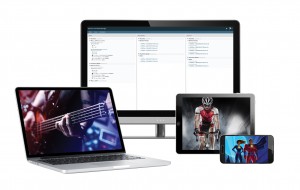SVG Europe Sit-Down: Imagine Communications’ Brick Eksten reveals thoughts on multi-screen viewership and the challenges of UHD

Imagine Selenio One XC: Selenio One XC provides distributed encoding, including high-quality ABR encoding
According to Imagine Communications, nearly half of the world’s video channels are using its products in some form or another, with its software solutions driving nearly $50 billion (£38billion, €43billion) in global ad revenue for those customers. Its work of continuous innovation, enables it to deliver advanced IP, cloud-enabled, software-defined network and workflow solutions. Beyond that, it has received prestigious awards – and that is where our Sit Down with its Chief Product Officer, Playout, Networking and Distribution, Brick Eksten, starts…
At NAB you were presented with a Best of Show Award for your Selenio One XC. What makes it so special?
Encoding/transcoding is a foundational technology of the new media industry, and the Selenio One platform, which is powered by Zenium microservices technology, provides the ideal platform for those critical operations.
Selenio One XC, and its counterpart XO, are really the first two parts of Imagine’s response to the requirement for transcoding and encoding solutions. Selenio One XC provides distributed encoding, including high-quality ABR encoding in the future.
It is an all-software solution, so it can run in a pure cloud environment, which we have already done for a number of different customers. But it can also run on a number of different platforms. You can have it running on everything from a single socket, low-power Intel CPU, up to multi-socket with dozens of cores running moderate density in 1RU. That is our focus: high quality and moderate density, with the Selenio One XO taking the same technology out to extremely high density.
Earlier this year you teamed up with the sports network MSG to expand its performance and capacity. What did this project involve and how does it especially help sports broadcasters?
MSG Networks needed to upgrade its playout facilities to deliver the extensive on-air and online services it offers, and to be ready for future developments. We had been working with the company for many years, and we were pleased they turned to us for their next-generation delivery platform.
We provided more than 80 channels of Nexio servers, with full integration to Adobe Premiere Pro. The system also included delivery servers and asset management. MSG covers multiple sports venues in the New York region, and the server network is connected over 10-gigabit ethernet links.
One of MSG Networks’ major business objectives was to build a playout and production facility capable of keeping pace with evolving technical requirements. In addition to supporting multiple codecs and formats, the entire system is ready for 4K and HDR Ultra HD and will seamlessly scale to accommodate future increases in storage requirements, including even higher resolutions.
‘Just-in-time’ packaging was commercialised a few years ago. Where are we now?
The simple answer is that we are moving from science project to real-world use cases.
The primary role of just-in-time packaging is in dynamic advertising replacement, delivering ads targeted right down to the individual. Every single commercial in a stream could be targeted for every single user. You can use it to target advertising, or you can use it to control blackouts on a very granular basis, maybe because of specific user rights, regions or time zones.
The great benefit of just-in-time packaging is that you do not need to store all those different variants of a single piece of content. Without it, if you had 100,000 users you would have to store 100,000 different versions of one piece of content, which is clearly impossible. With just-in-time packaging you store one version alone, and make all the variations as the content is accessed on a user-by-user basis.
Obviously, it is ideal for OTT, and it is now being widely used by cable companies to control the monetisation of their on-demand services. But I see it as an opportunity in the future in ATSC 3.0, as well.
What improvements are we likely to see in remote production over the next one or two years?
Remote production is very popular in Europe, where they have the infrastructure already in place to support it. In sports, it gives you the ability to bring more production infrastructure, more finesse and engagement in the coverage, because you can build a more comprehensive permanent production facility than you could ever hope to create in a mobile unit.
As usage grows, we will see a continual improvement in resolution scaling, via low-latency codecs and circuits. The first benefits will be the ability to cover minor sports and lower leagues with the ability to meet the standards we associate with top-flight events — perhaps in OTT services.
Multi-screen viewership is increasing. What trends can we expect?
Multiscreen has gained a reputation for a less-produced version of the core content itself. Advertising is not quite as valuable, so production values for the content may not be quite so high.
I see this perception gap quickly closing, as broadcasters get their arms around the technology. We see more and more broadcasters taking ownership of the multiscreen delivery experience.
We are really pushing forward with what we call unified distribution and unified production. This is where the production itself and the distribution of content is done as an ABR stream and as fragmented packets. Everything from broadcast through OTT to mobile devices is done as one production, with every output just another client in a holistic workflow that targets multiscreen first.
Once it is all one pipeline you will start to see more synchronicity across delivery, which, of course, improves the experience as you move from your big screen to OTT to mobile devices. The result will be a continuing improvement in overall user experience.
Is there still some resistance to using cloud solutions?
I wouldn’t call it resistance. Most customers are somewhat accepting of the cloud for very specific solutions. One of the best use cases we have today is around disaster recovery. Our initial thought was that disaster recovery in the cloud is the economical solution, because you only need to run it when it the main centre fails. But what we have actually found with a couple of customers is that by the time they have modelled it all out, they are actually doing primary from cloud and are doing DR locally. It turns out that it is actually cheaper to run the DR locally, and mechanically it makes more sense.
Cloud is not a panacea, and there is no dynamic to move everything to the cloud. What it is good at is scale. Think about addressing hundreds of thousands of individual customers on OTT: that is a good example of cloud scaling.
The key thing is to work closely with a trusted supplier, like Imagine Communications, to model the economics. In most cases we find that some part of a business can beneficially be moved to a cloud environment.
What challenges does Ultra HD present?
We have been delivering UHD capable systems for a while, and we are comfortable we are ready to support our customers. There is a bit of confusion around colour formats and standards, but these are readily sorted.
The real challenge around UHD is a business problem. How do broadcasters monetise it? It requires a fundamental change in their infrastructure, or at least an additional overlay of technology, which we can provide if they can justify the investment.
Consumers can go out and buy a 4K television, and even a 4K camcorder. But there is very little content. I was talking to people at NAB who said they had to watch YouTube as it was the only source of 4K content available to them.
What happens to broadcasters? Do they carry the costs just to get a competitive edge? If they are in their technology cycle where they are replacing traditional infrastructure with IP then they may be able to add 4K relatively easily. And once one broadcaster starts, the others will be forced to follow.
Right now, the discussions we are hearing are much more around HDR than 4K. People want to go to 1080 HDR because it delivers a real, perceptible jump in quality for the consumer in a much more practical way. 1080 HDR fits in with the broadcast economic model, while 4K requires a fundamental shift in processing loads and technology investment.

